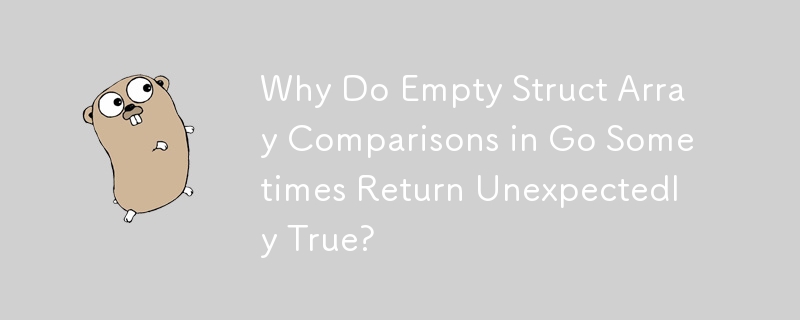

Why Array Comparisons of Empty Structs Yield Unexpected Results
In Go, an array of struct pointers can lead to unexpected results when comparing arrays of empty structs. This article delves into the reasons behind these puzzling outcomes.
Empty Struct Comparison
When comparing empty structs, the Go specification states that pointers to two distinct zero-size variables may or may not be equal. This means that &&s == &ss can evaluate to either true or false for empty structs s and ss. The behavior may vary between different runs of the same program.
Array Comparison
Initially, we may expect that comparing arrays of empty struct pointers (arr1 == arr2) would always result in false since they refer to different sets of memory addresses. However, in some cases, they unexpectedly yield true.
Escape Analysis Effects
The behavior is influenced by escape analysis, which determines how variables are stored in memory. When &s and &ss are passed to a function, like fmt.Println(), they escape the function's scope and are allocated on the heap. This allocation process can alter their addresses, leading to unexpected comparisons.
Consider the following code snippet:
var s, ss struct{}
arr1 := [6]*struct{}{&s}
arr2 := [6]*struct{}{&ss}
fmt.Println(&s == &ss, arr1 == arr2) // true, trueIn this case, escape analysis identifies that &s and &ss escape the main function and allocates them on the heap. This allocation process introduces a change in their addresses, resulting in both &s == &ss and arr1 == arr2 evaluating to true.
Conclusion
Comparing arrays of empty struct pointers can yield unpredictable results due to the possibility of equal addresses for distinct variables, particularly when escape analysis is involved. To avoid unexpected behavior, it's recommended to explicitly initialize struct values or to use slices instead of arrays when dealing with empty structs.
The above is the detailed content of Why Do Empty Struct Array Comparisons in Go Sometimes Return Unexpectedly True?. For more information, please follow other related articles on the PHP Chinese website!




